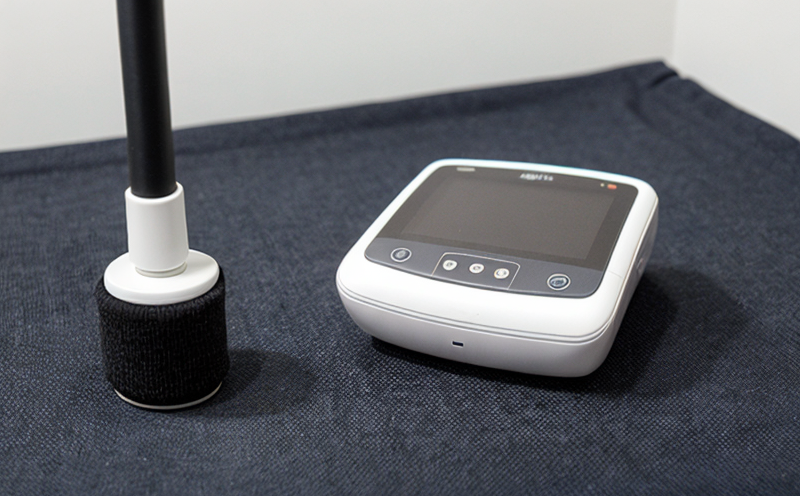ISO 6330 Laundering resistance of conductive yarn fabrics
The ISO 6330 standard specifies methods to determine the laundering resistance of conductive yarn fabrics. This testing is crucial for ensuring that textiles maintain their electrical and physical properties after multiple wash cycles, which are essential in various industries such as electronics, aerospace, and healthcare.
Conductive yarns play a vital role in applications where functionality is paramount, such as ESD (Electrostatic Dissipation) protection clothing, smart fabrics for wearable technology, and medical textiles. The laundering resistance test evaluates how well these materials retain their conductivity over time. This is particularly important when dealing with high-performance fabrics that must endure regular use and washing.
The testing process involves exposing the conductive yarn fabric to a series of wash cycles under controlled conditions. After each cycle, samples are analyzed for changes in electrical resistance. The standard defines acceptance criteria based on pre-determined thresholds of conductivity loss or gain. Compliance with these standards ensures that the product maintains its intended functionality throughout its lifecycle.
Proper specimen preparation is critical to achieving accurate results. Specimens should be cut from the fabric according to specified dimensions and orientation, ensuring they are representative of the entire piece. Pre-washing can also be required before testing begins, depending on the specific requirements outlined in the standard.
The test apparatus typically includes a washing machine designed for industrial use, capable of replicating real-world washing conditions while allowing precise control over variables like temperature, detergent type, and cycle duration. A drying chamber is also necessary to ensure samples are dried under controlled conditions after each wash cycle.
Testing procedures vary slightly depending on the exact nature of the fabric but generally follow a standardized protocol. Samples undergo multiple wash cycles, followed by thorough rinsing and drying. Conductivity measurements are taken before and after each cycle using appropriate instruments such as four-point probes or two-electrode testers connected to a multimeter.
Acceptance criteria vary based on the specific application of the fabric. For instance, ESD protection garments may have stricter requirements than smart textiles used in fashion. Compliance with ISO 6330 ensures that products meet industry standards and customer expectations for durability and reliability.
- Proper specimen preparation: Specimens should be cut from the fabric according to specified dimensions and orientation, ensuring they are representative of the entire piece. Pre-washing can also be required before testing begins.
- Controlled washing conditions: The test apparatus includes a washing machine capable of replicating real-world washing conditions while allowing precise control over variables like temperature, detergent type, and cycle duration.
- Thorough rinsing and drying: Samples are thoroughly rinsed after each wash cycle to remove all detergent residues. They are then dried under controlled conditions to ensure accurate conductivity measurements.
- Conductivity measurement: Conductivity is measured using appropriate instruments such as four-point probes or two-electrode testers connected to a multimeter.
Quality and Reliability Assurance
The quality and reliability assurance process in ISO 6330 testing involves several key steps to ensure accurate and consistent results. These include proper specimen preparation, adherence to controlled washing conditions, thorough rinsing and drying procedures, and precise conductivity measurements.
- Proper specimen preparation: Specimens should be cut from the fabric according to specified dimensions and orientation, ensuring they are representative of the entire piece. Pre-washing can also be required before testing begins.
- Controlled washing conditions: The test apparatus includes a washing machine capable of replicating real-world washing conditions while allowing precise control over variables like temperature, detergent type, and cycle duration.
- Thorough rinsing and drying: Samples are thoroughly rinsed after each wash cycle to remove all detergent residues. They are then dried under controlled conditions to ensure accurate conductivity measurements.
- Conductivity measurement: Conductivity is measured using appropriate instruments such as four-point probes or two-electrode testers connected to a multimeter.
International Acceptance and Recognition
The ISO 6330 standard for laundering resistance of conductive yarn fabrics is widely recognized and accepted across various industries. Its global acceptance ensures that products meet international quality standards and are suitable for use in diverse applications.
The standard's rigorous testing procedures and clear acceptance criteria provide manufacturers with a reliable framework to ensure their products perform consistently under real-world conditions. This recognition enhances trust among customers, suppliers, and regulatory bodies worldwide.
Use Cases and Application Examples
The ISO 6330 standard finds application in numerous industries where conductive yarn fabrics are used for their unique properties. These include ESD protection clothing, aerospace components, medical textiles, and wearable technology.
In the field of ESD protection, ensuring that garments maintain their conductivity after multiple wash cycles is critical to safeguarding personnel from potential hazards associated with static electricity. Aerospace applications benefit from materials that can withstand harsh environmental conditions while retaining essential electrical properties.
For medical textiles, maintaining conductivity ensures proper functionality in devices and garments used for therapeutic purposes. In wearable technology, the standard supports innovation by ensuring that fabrics retain their smart capabilities even after repeated use and washing.





